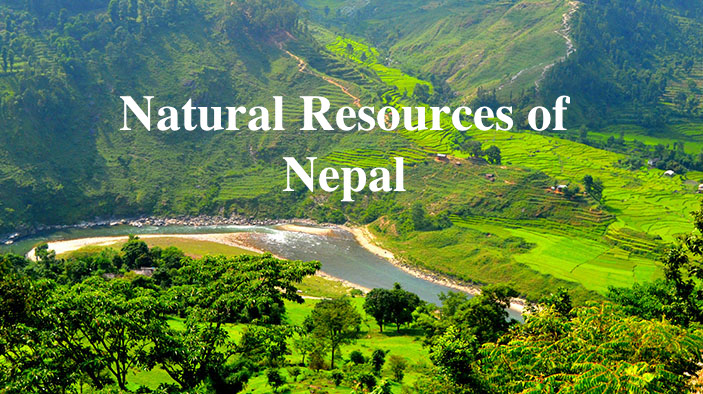Introduction
Natural resources are productive resources that are provided by nature free of charge. They are also called natural capital. Natural capital is as important as physical and human capital for the overall development of a country. Natural resources include land, climate, forests, water, minerals, etc.
Natural resources can be renewable or non-renewable, depending on whether or not they refill naturally. Renewable resources are those resources that can be restored or updated naturally over time. The main characteristic of renewable resources is their ability to regenerate, i.e., Stock is not fixed and can go down and up. For example, fish and trees are renewable resources. Non-renewable resources are limited natural resources. These resources cannot be renewed or refilled in a short duration. Therefore, they are also known as exhaustible resources. For example, coal, natural gas, petroleum, etc. are non-renewable resources.
The proper use of natural resources makes the country rich. Most western countries have become rich by mobilizing their natural resources, especially mineral resources. Arab countries are rich only because of their large oil reserves.
Nepal is a mountainous country. It is an underdeveloped country with different natural resources such as water, minerals, forest, varieties of agricultural products and medical herbs. For the economic development of the country exploitation and proper use of such valuable resources is extremely important. The situation of the country’s basic natural resources is explained below.
Water Resources
Water is Nepal’s most important natural resource. Nepal is the second richest country in the world in terms of water resources. The major sources of water are – glaciers, snowmelt from Himalayas, rainfall and groundwater.
Depending on their origin, the rivers of Nepal can be broadly divided into three categories: The first category consists of the country’s four main river systems: the Koshi, Gandaki, Karnali and Mahakali rivers, all of which originate from glaciers and snow-fed lakes. The second category consists of the rivers that originated from the Mahabharat range, which includes Babai, West Rapti, Bagmati, Kamala, Kankai, Mechi, etc. The third category consists of streams and rivulets that originate mostly from the Chure hills. These rivers cause flash floods during the rainy season and remain without flow or very little flow during the dry season. It is estimated that there are 6,000 rivers in Nepal (including rivulets and tributaries) having a total length of about 45,000 km.
Besides these, there are lots of lakes and ponds in Nepal. Rara Tal (Mugu), Shey-Phoksundo (Dolpa), Phewa Tal, Rupa Tal, Begnas Tal (Pokhara), Gaduwal Tal (Chitwan), Satyavati Tal (Palpa), Khaptad Tal (Doti), Barhakunetal (Dang), Surma Sarobar (Bajhang) and Tilicho Tal (Manang) are some of Nepal’s well-known lakes.
Role/Importance of Water Resources
Water resources play an important role in the economic development of Nepal. Being one of the important sources of energy, it is also termed as “White Coal”. Nepal has been designated as the “Water Resource Capital of South Asia”. The roles of water resources in the Nepalese economy are as follows:
1. Source of Energy: The availability of abundant water resources and geophysical features of the country provide ample opportunity for hydropower production in Nepal. This is the source of energy that contributes to the development of transportation, communication, and every sector of the economy.
2. Development of Agriculture Sector: Water resource is the basis of irrigation and irrigation is the lifeblood of agriculture. Adequate provision of irrigation helps to diversify crops and to increase agricultural productivity. Thus, the development of the agriculture sector depends directly on water resources. The agro-based industries such as sugar, jute, cigarette, flour, rice, oil, paper, etc. can also be established by using electricity produced from water resources.
3. Development of Industrial Sector: The heavy machinery of large-scale industries cannot run/operate without electricity. So, it is necessary to generate power for industrial development. Generating adequate electricity from the rivers helps to develop the industrial sector of the country. This reduces the cost of petroleum products to run diesel plants and saves foreign currency.
4. Development of Tourism: The tourism industry depends on the natural beauty of the country. Nepal is rich in rivers, lakes, waterfalls and many more that contribute to the natural beauty of the country. The development and preservation of natural beauty is important to increase the number of tourists from various parts of the world. Besides tourists also visit Nepal for rafting, boating, fishing, etc.
5. Development of Alternative Transport and Communication: Electricity replaces the use of petroleum products and coal. Electricity generated from water resources can be used to run electric vehicles such as trolleys, cable cars, railways, ropeway, etc. Water resources are also useful for the development of water transportation such as rafting and shipping. It may help to initiate a water transit facility. In the same way, the means of communication such as telephone, internet, fax, radio, T.V., etc. can also be operated by using hydropower.
6. Basis of Health: The development of water resources helps to provide pure drinking water which is the basis of healthy life. The availability of safe drinking water helps not only to increase labour productivity but also to improve the standard of living.
7. Basis of Forest Conservation: The development of hydropower replaces the use of wood as fuel. In Nepal, fuel wood provides almost 62.5% of total energy consumption. The use of wood as fuel is one of the main causes of deforestation. Therefore, the development of hydropower can protect the forest resources of Nepal.
8. Employment Promotion: Proper utilization of water resources helps to develop almost every sector of the economy. The development of the agriculture, industry and tourism sectors increases economic activities in the country. This may create employment opportunities in these sectors.
9. Export Promotion: Water resource is considered as “white coal” for the Nepalese economy. It can be used for the development of the industrial sector which helps to increase the export volume of goods and services. Besides, electricity generated from water resources can be exported to earn foreign currency.
Potentiality of Hydroelectricity in Nepal
Nepal is rich in water resources. It ranks second in the world in terms of water resources (Brazil is the first). The main sources of water in Nepal are rivers, lakes and groundwater. There are about 6000 rivers and rivulets in Nepal. Most of the rivers in Nepal are originated from the mountains. They reach the Terai region via hilly region with high speed. Therefore, electricity can be easily generated by building dams on these rivers.
The potentiality of hydroelectricity in Nepal is about 83,000 MW, which is 2.27% of the world’s total hydroelectricity potential. However, only 44,370 MW of the potential capacity is techno-economically viable. It is expressed in the
table 5.2.1:
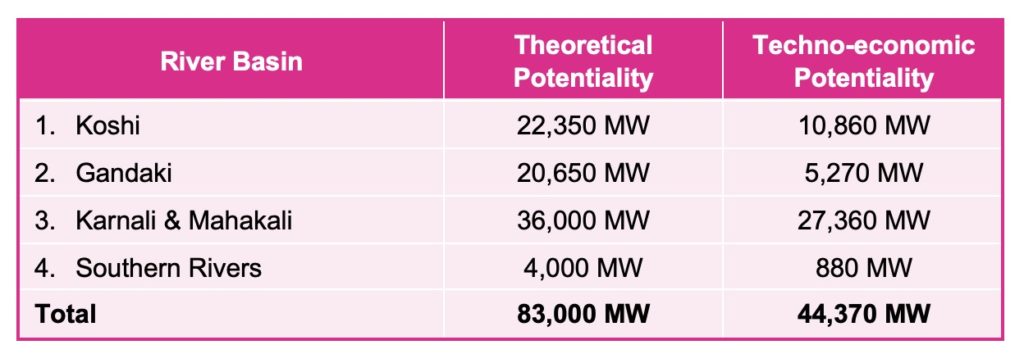
Thus, even though small in size, Nepal is extremely prosperous in terms of water resource potential. Apart from this, it is possible to export electricity to India, Pakistan, Bangladesh, etc. Therefore, there can be no disagreement over Nepal’s economic development if it can be utilized to its full potential.
Current Situation of Hydroelectricity
Though Nepal has a large amount of water resources with high energy potential, there are no significant successes in generating electricity.
By mid-March 2022, a total of 2,022 MW hydroelectricity has been generated from various hydropower projects, which is around 2.44 percentage of the total potentiality. Total installed electricity is 2205 MW, out of which hydroelectricity is 2022 MW. It is clear from table 5.2.2.
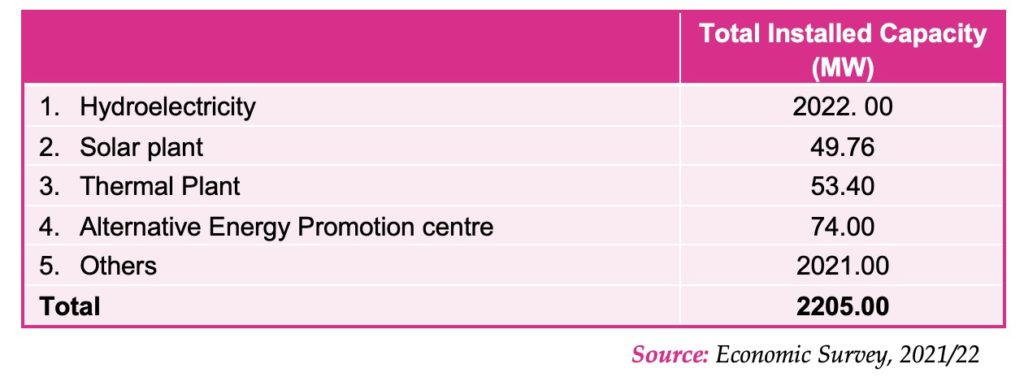
The first hydro project in Nepal is Pharping hydroelectricity project (500 KW), installed in 1911 A.D. Today, hydroelectricity is accessible to all 77 districts of the country and the people who benefited from it are about 94% of the total population. Further investment is needed in this sector to achieve the sustainable development goal of making easy access to energy for all populations by 2030 AD.
While analyzing the sector-wise consumption of electricity by mid-March 2022, it is found that the household sector consumed 45 percent, the industrial sector 38 percent, the commercial sector 7 percent, and the miscellaneous sector 10 percent.
The major hydropower projects are as follows:
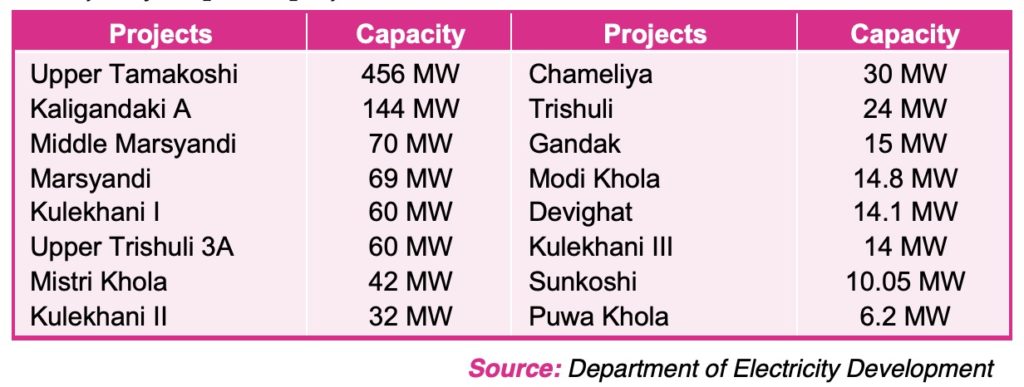
Tanahu Hydropower Project (140 MW), Rahuganga HEP (40 MW), Dordi Khola (27 MW), Upper Sanjen (14.6 MW), Sanjen (42.5), Rasuwagadi (111. MW), Madhya Bhotekoshi (102 MW), Upper Trishuli 3B (37 MW), are some of the major hydropower projects under construction.
Current Situation of Irrigation
Irrigation is an important use of water resources. It is the lifeblood of agriculture. The expansion of irrigation facilities can lead to crop integration and crop diversification, which can help to create employment opportunities and to reduce poverty.
In Nepal, out of the total geographical area of 1,47,51,600 hectares, the land suitable for arable agriculture is estimated to be about 26,41,000 hectares (17.9% of the total geographical area). Out of this land, the potential irrigable area under surface and groundwater sources is about 17,66,000 hectares (67% of arable land) owing to the rugged topography and landform. But at present, only 15,12,432 hectares of land has irrigation facility.
Table 5.2.4 shows the irrigation facility available in the country by Mid-March 2022.

However, due to the lack of availability of a sufficient amount of water in the source and delays in implementation of the projects of water transfer and multi-purpose water reservoir projects, it is distressing to note that only 33.0 percent of areas of irrigated land are estimated to get year-round irrigation facility.
The major irrigation projects of Nepal are as follows:
1. Bagmati Irrigation Project
2. Purbi Rapti Irrigation Project
3. Mahakali Irrigation Project
4. Bhairahawa Lumbini Irrigation Project
5. Chandra Mohan Irrigation Project
6. Narayani Irrigation Project
7. Sikta Irrigation Project
8. Rajapur Irrigation Project
9. Babai Irrigation Project
10. Sunsari-Morang Irrigation Project
Despite the investment of billions of rupees, the result achieved so far is not satisfactory. The main reasons behind this are lack of proper maintenance of completed projects, landslides, floods, etc.
Current Situation of Drinking Water
Drinking water is essential for human existence. Without it, life is impossible. Nepal has abundant natural resources in the form of water. However, Nepalese people face a shortage of safe drinking water both in rural and urban areas.
The major sources of drinking water in Nepal are piped water, tube well, spring and others. Piped water alone constitutes about 50% of the total drinking water supply in Nepal. The systematic drinking water system was started in 1951 AD when Bir Dhara was built.
By the end of the 14th Plan (2016/17 – 2018/19), 88% of people had access to safe drinking water facilities. However, this figure does not reflect the real situation as this figure also includes the past projects which are not in use these days. The 15th Plan (FY 2019/20 – 2023/24) has set the target to provide drinking water facilities to 99% of the total population. By the mid-March 2022, about 93.35 percent of toal population has access to drinking water facility.
After a decades-long wait and missing countless deadlines, water from the Melamchi River in Sindhupalchok district has finally made it to Kathmandu. This helps to reduce the problem of the drinking water supply in Kathmandu. This project has the capacity of 17 crore litres of water per day. This project was started in 1998 AD and Completed in 2021 AD.
Problems of Water Resource Development in Nepal
The major problems of water resources development in Nepal are as follows:
1. Inadequacy of Capital: The development of water resources requires a huge amount of capital. But being a poor country, there is not enough capital in Nepal. As a result, Nepal cannot undertake large hydroelectricity and irrigation projects without any external support. So far, such projects have been completed with foreign assistance (bilateral and multilateral).
2. Lack of Technology and Technicians: Technical knowledge is very important for the development of water resources. However, technicians having high-level technical knowledge are still lacking in Nepal. Therefore, Nepal has to buy high-tech technicians from other countries.
3. Lack of Transportation and Communication: Transportation and communication facilities are essential in order to conduct projects regarding water resources. Most of the hydroelectricity projects are located in hilly areas where transportation and communication facilities are very difficult to access.
4. Limited Market: The market for water products is limited. The purchasing power of Nepalese people is very low. The only foreign market is India. But Indian policy regarding these products is not favorable.
5. Defective Government Policy: Government policies on water resources development is neither appropriate nor effective. There is lack of adequate statistical data regarding current situation of water resources. Nepal government has adopted open door policy for private investment but the policy and legal provisions are neither adequate nor clear-cut.
6. Rugged Geographical Terrain: Nepal is a hilly country. Most of the projects related to the water resource development are located in hilly areas with uneven geographical terrain. Due to this uneven geographical situation, development of transport and communication system in these areas is very difficult which causes difficulties in the development of water resources in Nepal.
7. Political Instability: Political instability that causes frequent changes in government has become a common feature of Nepal since the restoration of multi-party democracy. As a result, there arise problems in the continuation of the existing projects, programs and policies with the change in government. This creates uncertainty in the economic activities which further discourages the entrepreneurs and reduces domestic and foreign investment.
Forest Resources
Nepal was very rich in forest resources in the past. It is evident from the old saying “Hariyo Ban Nepal Ko Dhan” i.e., the green forest is the wealth of Nepal. Nowadays such a slogan is kept in the books of Nepalese economic history. This is not because of its declining importance but because of the massive deforestation in the country. Forest is one of the renewable natural resources. Hence, scientific management and utilization of the resource can accelerate the pace of economic development of the country.
Role of Forest Resources
Forest resources are a prerequisite for the development of agriculture, industry, water resources, etc. The role/importance of forest resources for the economic development of Nepal can be explained as follows:
1. Basis of Preserving Natural Eco-system: For ecological balance, at least 43% of the total area should be covered with forest. Forest is the source of oxygen. Living things can’t survive without forests. Forests are the natural habitat of various species. So, forest resources help to prevent precious species from being extinct which helps to preserve bio-diversity.
2. Backbone of Agriculture: Forest is the mother of the agriculture sector. Leaf litter and animal beddings are collected from the forest, which is a source of compost manure. Forests help to maintain the level of groundwater that helps in irrigation. Besides, the forest can prevent soil erosion and landslides as trees have gripping power.
3. Basis of Raw Materials for Industries and Construction: The raw materials for the forest-based industries like paper, matches, paints, medicine and varnish and turpentine processing are available from the forest. Similarly, timber and wood for the construction of bridges, houses, etc. are also obtained from the forest.
4. Source of Energy: Forests are the main sources of energy in Nepal. About 60% of total energy consumption in Nepal is obtained from forests. Nepalese people are consuming fuel wood for heating and cooking purposes. Fuel wood is also used extensively in brick and mine kilns, rural industries, restaurants, etc.
5. Promotion of Tourism: Forest enhances the natural beauty of the country. Forest management can preserve rare wild lives: elephants, tigers, rhinos, musk deer, panda, etc. have been the source of tourists’ attraction in various wildlife conservations in Nepal.
6. Source of Public Revenue: Forest is one of the sources of government revenue in Nepal. It provides both tax and non-tax revenue by selling the forest products like timber, herbal products, etc.
7. Export Promotion: Trade deficit is a chronic problem in Nepal. The development of forest resources helps to increase the export of forest-related products such as paper, timber, medicinal herbs, etc. This helps to increase foreign exchange earnings and to reduce the problem of trade deficit.
Forest is an integral part of rural livelihood in Nepal as shown in the figure 5.2.1.
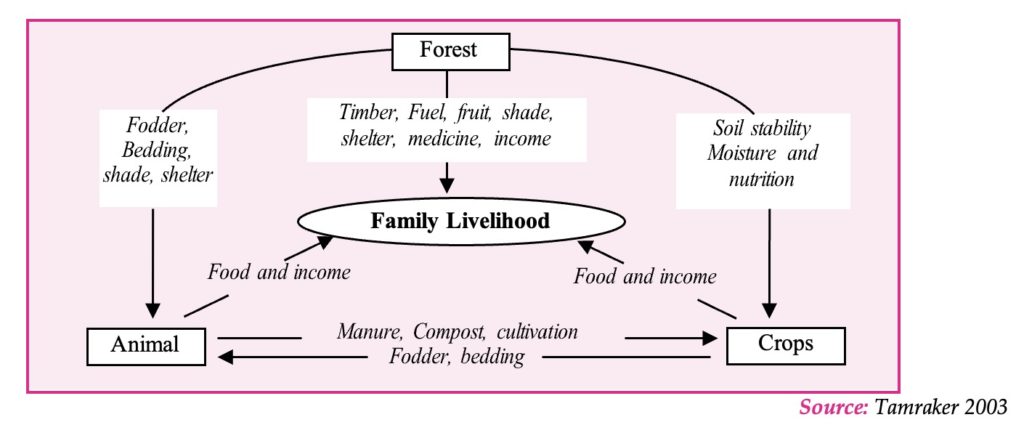
Current Situation of Forest Resource
Nepal was rich in forest resources in the past. From this has originated the saying “Green Forest is the Wealth of Nepal“. But that is far from being true at present.
According to Economic Survey 2021/22, 30.8 percent of the total land area of the world is covered by forest, this area is equivalent to 0.6 hectares per person and 422 trees per person.
In Nepal, forest occupies a total of 59,062 sq. km which is 40.4 percent of the total area of the country. Other shrub land covers 6048 sq. km (4.4%). Forest and shrub land together represent 44.8 percent of the total area of the country. This implies that there are 0.2 hectares of forest areas and 111 trees per person in Nepal. According to the landscape distribution of forest areas, the mid-hill has the highest coverage and the Terai has the lowest coverage.
At present, about 23.3% of the total area is covered with national parks, wildlife reserves, conservation areas, hunting reserves and buffer zones. Out of the total 20 Protected Forest Areas, 12 National Parks, one Wildlife Reserve (Kosi Tappu), one Hunting Reserve (Dhorpatan), and six Conservation Areas have been preserved through the Department of National Parks and Wildlife Conservation. Three conservation areas (Annapurna, Manasalu and Gaurishankar), have been preserved through National Trust for Nature Conservation (NTNC), and one Conservation Area (Kanchanjunga) has been managed by the local community. Eco-tourism programs have been implemented in these areas. So, these protected areas contribute to the National economy through tourism and also help to protect important national species and biodiversity.
Causes of Deforestation
The main causes of deforestation are discussed as follows:
1. Source of Livelihood: Around 18.7% of people in Nepal are living below the poverty line. Due to limited employment opportunities, they collect herbs and other forest products and make a living by selling them.
2. Migration: Due to the low agricultural productivity and lack of employment opportunities in hilly areas, people move from hilly regions to Terai region. Such migrated people tend to live nearby the forest area because of the easy availability of their daily needs from the forest without cost. Due to the open border, external migration has also become one of the causes of deforestation in Nepal.
3. Lack of Employment Opportunity: In Nepal, about 66% of the total population is engaged in agriculture where seasonal unemployment and disguised unemployment are widespread. Due to the lack of alternative employment opportunities outside agriculture, they use forest resources as a source of additional income.
4. High Population Growth Rate: According to the preliminary population census report 2021, Nepal’s total population is 29.19 million and it is compounding annually at the rate of 0.93%. Increased population causes increased demand for energy, food grain, and construction materials. This aggravates the problem of deforestation.
5. Lack of Alternative Source of Energy: About 36.81% of Nepalese people are living in rural areas where alternative sources of energy, other than fuel wood are not easily available. If available then also they cannot afford commercial energy like kerosene and gas due to low levels of income. So, they depend on forest resources which is another cause of deforestation.
6. Demand for Raw Materials: There are several forest-based industries such as matches, paper, herbal, furniture, etc. They collect their raw materials from the forest. The dependency of such industries on the forest is one of the causes of deforestation in Nepal.
7. Ineffective Administration and Absence of Forest Management: There is no effective administration and forest management policy. Due to a lack of clear forest policy and weak administration, poachers and illegal traders are not punished properly. Due to the lack of training for forest workers and their users, deforestation is aggravated. Political instability also adds fuel to the fire of forest destruction.
There are also other causes of deforestation such as the high dependency of the farming system on the forest, illegal trade, uneducated people, etc.
Consequences of Deforestation
The consequences of deforestation in Nepal are as follows:
1. Natural Calamities: Deforestation causes floods, landslides, deficiency of rainfall and various diseases. In this way, deforestation creates the situation of natural calamities. Hence, deforestation means breaking the natural balance.
2. Environmental Degradation: Forest helps to keep the environment clean. According to experts, at least 43% of the total land area should be covered by forests for ecological balance. Deforestation causes climatic changes and irregular rainfall. Irregular rainfall causes drought and floods, soil erosion, landslides, etc. Deforestation also causes the decline and even extinction of various species of wild animals and plants. This shows that deforestation has a negative impact on the environment.
3. Extinction of Endangered Animals and Plants: Forests are the natural habitat of animals, birds and plants. Deforestation causes the extinction of endangered animals and plants such as elephants, tigers, rhinos, etc., which have a negative impact on the ecosystem and tourism industry.
4. Effect on Agriculture: Forest resources are closely related to agriculture in many ways. Deforestation causes soil erosion, irregular rainfall, and water scarcity, which in turn decrease the productivity and production of soil. Therefore, deforestation affects agriculture negatively.
5. Effects on Industries: Deforestation has a negative impact on the industrial sector. This leads to a reduction in the supply of raw materials for forest-based industries like paper, medicine, furniture, etc. Employment and public revenue are also affected.
6. Decline in Groundwater: Groundwater is one of the major sources of water supply in Nepal. Especially in the Terai region, people use groundwater for the purpose of household uses and irrigation. The level of groundwater largely depends on the forest area. Deforestation causes a decrease in water which increases the problem of water scarcity.
7. Negative Effects on the Economy: Deforestation destroys natural beauty, bio-diversity, and endangered animals and birds. It also pollutes the environment. Consequently, there will be a decrease in tourist arrivals in the country. This reduces foreign exchange earnings.
Mineral Resources
The mineral resource is one of the important natural resources. Gold, Silver, Copper, Coal, gas, limestone, etc. which are found in the womb of the earth are called mineral resources. They are nonrenewable natural resources. Sustainable development of such resources helps to strengthen the national economy.
Nepal being a hilly country should possess a sufficient amount of such minerals. From the very beginning, metals like iron and copper are said to have been utilized in different parts of the country. Several industries have been established based on mineral resources, which are available in different places. The contribution of mineral resources to the GDP is estimated at only about 0.65%. If we can develop the mineral industries well, it can play a great role in the economic development of the country.
Role/Importance of Mineral Resources in Economic Development
Mineral resources play an important role in the economic development of a country. They contribute to a country’s development by generating foreign direct investment, export earnings, government revenues (through royalties, taxes, licenses and fees), gross domestic product (GDP) growth and employment.
The role of mineral resources in the economic development of Nepal can be explained as follows:
1. Development of Agriculture Sector: Minerals such as metals are used in manufacturing agricultural tools and implements like spades, machines and irrigation devices for agricultural development. The mineral (Pyrite) available in Nepal is very useful for the production of chemical fertilizers.
2. Development of Industrial Sector: The development of the industrial sector of a country largely depends on the availability of mineral resources. Mineral deposits are the basis of raw materials, machinery and equipment needed for industry. Agriculture lime, marble, lead, cement, etc. are the main mineral-based industries in Nepal.
3. Development of Transport, Communication and Electricity: The development of transport and electricity needs heavy equipment, which are the outcomes of mineral resources.
4. Source of Energy: The optimal use of natural resources such as petrol, diesel, and natural gas, can meet the increasing energy demand. They can replace imports of petroleum products and help to reduce the problem of trade deficits.
5. Employment Opportunities: Most of the people in Nepal are engaged in agriculture, where unemployment and disguised unemployment are common. The development of mineral resources requires more employment and reduces the unemployment rate in the country.
6. Source of Public Revenue: Optimum use of mineral resources helps to establish large-scale industries. Nepal has a greater scope of cement, iron, zinc, coal, etc. The government can impose VAT and other duties on these products which are the major sources of public revenue.
Current Situation and Potentiality of Mineral Resources
It is believed that Nepal is rich in mineral resources. Preliminary geological surveys reveal that there are varieties of mineral ores, natural gas, coal, etc. deposited in the various parts of Nepal. However, the extent and possibility of commercial utilization of those mineral deposits are yet to be known. Based on various geological surveys, the current situation of mineral deposits in Nepal is outlined below:
1. Iron Ore: Iron is the principal metal which is used extensively in infrastructure development works, and manufacturing heavy machinery equipment, arms and agricultural tools. In Nepal, iron ore deposits have been found in Fulchoki (10 million tons of iron ore are estimated to be deposited), Labdikhola (10 million tons of iron ore are estimated to be deposited), Thoshe (8 million tons), Jirwang (1 million ton). Besides, iron ores have been found in Kulekhani, Godawari, Bhaise, Pyuthan, Bandipur and so on.
2. Copper: Copper is another important metal which is mainly used in electrical industries to produce electrical and electronic equipment, copper wires, crafts, utensils, and other household purposes. Copper ore is expected to be found in about 30 places. These places are: Bhotkhola, Gyaji, Arkhaule, Nangre, Wapsa, Siddhakhani, etc. but the amount has not been ascertained.
3. Magnesite: 180 million tons (66 million tons of high grade, MgO content 88 to 96% loss-free basis) of magnesite deposit in Kharidhunga, Dolakha; 20 million tons of medium to low-grade magnesite deposit in Kampughat in Udayapur district; and few small size magnesite occurrences from Palpa, Baitadi and Dolakha have been identified.
4. Mica: The mica mines have been found in Bajhang, Chainpur, Doti, Bhojpur, Lamjung, Gosaithan, Nuwakot, Dhankuta and so on. But the quantity has not been ascertained.
5. Limestone: Limestone is the most important raw material for the cement industry. Limestone is found in Chovar, Jogimara, Bhainse, Rasuwa, Baglung, Pulchowki, Baitadi, Tipling, Salmor valley and so on.
6. Lead: Lead is found in Arkhaule, Durlung, Rasuwa, Baglung, Pulchowki, Baitadi, Tipling, Salmor valley and so on.
7. Coal: Coal is available in Dang, Sallyan, Rolpa, Pyuthan and Palpa districts. Small-scale 19 coal mines are in operation in these districts. In addition to that 30 prospecting licenses are also issued. Present coal production in Nepal is insignificant.
Moreover, other notable minerals like slate stone, petroleum and natural gas, zinc, nickel, gold, graphite, marble, pyrite, etc. are expected to be deposited in various parts of Nepal.
Problems of Mineral Resources Development
Most of the mineral resources are found only in paper. The causes of non-identification and non-exploitation of mineral resources are as follows:
1. Inadequacy of Capital: A large amount of capital must be invested in developing mineral resources. However, Nepal is a poor country and the pace of capital formation is very slow. Due to the inadequacy of capital, there has not been enough capital investment for the development of this sector.
2. Lack of Technology and Technicians: Exploitation of mineral resources requires highly efficient technicians and modern technology. But, there is a lack of such technicians and technology in Nepal. So, the country has to rely on foreign experts for the development of this sector.
3. Lack of Infrastructure: Nepal is a hilly country. Most of the mineral resources are supposed to be deposited in hilly areas. There is a need for basic infrastructure such as transport, communication and electricity for the exploitation of mineral resources. But these facilities are not available in mineral deposited areas.
4. Defective Government Policy: There should be an adequate and appropriate mineral policy to ensure the speed of mineral resource development in the country. Such policy should cover various aspects of mineral resource development including exploration, exploitation, processing, research, investment, etc. But there is no appropriate mineral policy in Nepal. In the absence of this, the government is unable to attract private investment in this sector.
5. Lack of In-depth Geological Surveys: The most important aspect of mineral resource exploration is in-depth geological surveys. In our country, except few preliminary geological surveys, so far there have not been adequate surveys. Due to this, there are no data on the quantity and quality of mineral resources available in the country.
6. Political Instability: Political instability that causes frequent changes in government has become a common feature of Nepal since the restoration of multi-party democracy. Frequent change in government causes problems in the continuation of the existing projects, programs and policies. This creates not only problems in developing mineral resources, but also in developing the country as a whole.
Natural Resource Management
Natural resource management refers to the management of natural resources such as land, water, plants and animals, etc. with a special focus on how management affects the quality of life for present and future generations. It deals with how people interact with landscapes. It integrates land management, water management, biodiversity conservation, and industrial sustainability in the future. It recognizes that people and their livelihoods depend on the health and productivity of our landscape. Thus, natural resource management refers to the sustainable use of the available natural resources for the sustainable development of the country.
According to National Planning Commission (NPC), “Natural resource management means to meet the present and future demand and need without depleting the existing stock of resources.”
This shows that there is a close relationship between the use of natural resources and the economic development of a country. However, careless use of these resources may lead to environmental pollution. Thus, natural resource management is in line with the concept of sustainable development. Haphazard use and depletion of natural resources create various problems such as air pollution, water pollution, water scarcity, atmospheric changes, hazardous wastages, soil degradation, deforestation and loss of bio-diversity. This shows the need for natural resource management for sustainable development, which implies both the use and preservation of natural resources. Thus, natural resource management is a question of the trade-off between present and future consumption.
Problems of Natural Resource Management
The major problems of natural resource management in Nepal are as follows:
1. High Population Growth Rate: High population growth rate is one of the major problems of natural resource management. When the population increases, demands for most of the goods and services increase. In order to fulfill these demands for goods and services of the growing population, there will be pressure on natural resources.
2. Inadequate Public Awareness: Most of the rural people of Nepal are uneducated and unaware of the scientific use of the available natural resources. As a result, they are using the available resources haphazardly. This creates problems in natural resource management.
3. Deforestation: Deforestation is another problem of natural resource management. Because of the high population growth rate and migration; maximum use of firewood as fuel for cooking; lack of awareness; forest resource is destroyed. This creates the problem of natural resource management.
4. Unscientific Urbanization: Due to unscientific urbanization and lack of disposal facilities, pollution is increasing in urban areas. In some parts of the country, drainage is connected to the river. It causes water pollution. Therefore, various animals and aquatic plants are gradually destroyed. This complicates the problem of natural resource management.
5. Use of Chemical Fertilizers: Nowadays, most of the farmers of Nepal are using chemical fertilizers in order to increase agricultural products in unscientific ways. Consequently, many animals and plants are being affected negatively resulting in problems in natural resource management.
6. Establishment of Industries: The establishment of industries is also responsible for polluting the environment. There is no provision for the control of pollution due to a lack of clear-cut policy. Consequently, air pollution is increasing in Nepal.
7. Increasing Number of Vehicles: The number of vehicles is increasing day by day in urban areas of Nepal. But road condition is not good to face the pressure of such an increasing number of vehicles. Further, the traffic system is also not scientific. As a result, air pollution is high in urban areas.
These are some of the problems of natural resources management or causes of environmental degradation.
Consequences of Natural Resource Mismanagement
The environmental problem is growing in developing countries including Nepal. Environmental mismanagement has serious effects on human health and productivity. The consequences of environmental pollution or natural resource mismanagement are as follows:
1. Soil Degradation: Environmental negligence leads to soil degradation which reduces the productivity of the agricultural sector. Due to this, the total production of main crops is decreasing day by day.
2. Water Pollution and Water Scarcity: Water pollution harms human health and lowers labour productivity. There is a frequent occurrence of water-borne diseases such as typhoid, diarrhoea, etc. There is a depletion of underground water which causes water scarcity for drinking, bathing, irrigation and industrial use.
3. Air Pollution: The use of energy, and smoke from vehicles and industries are causing air pollution. This is creating breathing-related diseases such as hypertension, high blood pressure, etc.
4. Loss of Bio-diversity: Environmental degradation reduces bio-diversity. It reduces the adaptability of the eco-system and the loss of genetic resources. There is eco-system overload, which means a state in which natural processes cannot recycle all the waste substances dumped into the environment. It results in the build-up of waste. Hence, if unchecked, it leads to the ultimate destruction of the environment and its capacity to sustain life.
5. Atmospheric Changes: The overproduction of carbon monoxide is the cause of depletion of the ozone layer which leads to different diseases related to air. It also increases global warming. The forest, agriculture and the whole ecosystem are affected by atmospheric changes.
6. Natural Calamities: Rapid deforestation leads to uneven rainfall which results in floods, landslides and various diseases.
7. Adverse Effect on Tourism Industry: Most tourists want to visit beautiful places in healthy environments. No one would be willing to visit polluted areas. Hence, environmental pollution will adversely affect the tourism industry in the country.
Measures or Suggestions for Natural Resources Management
Following are some of the suggestions for natural resource management.
1. Afforestation: Afforestation helps to prevent soil erosion, landslides, flood and drought. For this, various afforestation programs should be launched.
2. Scientific Use of Natural Resources: Mineral resources are limited in Nepal. We cannot increase the stocks of mineral resources as per our wish. Therefore, we have to use these resources rationally for sustainable development.
3. Enactment of Legal Provision: The rules and regulations must be transparent and they should be implemented effectively. Legal provision is most urgent to utilize the mineral and forest resources of Nepal.
4. Environmental Education: Almost all people depend upon natural resources in different ways. But most of the people of Nepal are not aware of the importance of natural resources. So they should be familiarized with the importance of natural resources via environmental education.
5. Establishment of Reserved Area: To protect various types of wild animals and plants, various reserved areas should be established. This is helpful for ecological balance.
Climate Change
Climate change is a change in global or regional climate patterns over time. It means changes in Earth’s temperature, humidity, air pressure, wind, clouds, and rainfall patterns over time.
As the world has developed and experienced drastic technological advances, improvements in healthcare and an ever-growing population with an ever-lasting demand for resources, pollution has become a major concern in the 21st century.
The unscientific urbanization, caused by high population growth and migration, has led to a decline in forest areas, exacerbating the problem of climate change in the economy.
In the process of economic growth and development, there has been an increase in the use of fossil fuels. This causes an increase in greenhouse gases in the environment. As more greenhouse gases are released into the atmosphere, the temperature of the Earth rises, leading to a chain of problems including rising sea levels due to the melting of glaciers and ice caps.
As economic growth and incomes rise, material items such as cars become more affordable. Consumers are more likely to use their car than public transport due to the inferior value that is placed on such services. This leads to a significant increase in the amount of polluting gases that are released into the atmosphere.
Impacts of Climate Change in the Economy
Climate change will have a wide range of socio-economic impacts. It not only affects important economic sectors such as agriculture, energy and health but will also cause changes in the supply and demand for goods and services in all sectors of the economy. Higher temperatures, rising sea levels, and other climatic changes (changes in regional rainfall patterns, water cycles, frequency and intensity of extreme weather events) also affect aspects of life that are not primarily based on economic activities such as human security, Health and well-being, culture, people’s capabilities, and environmental quality.
Some of the impacts of climate change on the economy are discussed below:
1. Impact on Agriculture: Climate change has a greater impact on the agriculture sector in the countries like Nepal, where agriculture depends on natural factors. It increases the cost of agricultural products. For instance, drought, heavy rainfall, floods and landslide causes the additional cost of production. The opportunity cost of crop production rises which might encourage farmers to switch their jobs. Furthermore, the decrease in production could increase the price of agricultural products.
2. Impact on Tourism: The effects of climate change make some tourist destinations less attractive and others more attractive. Weather patterns have become unpredictable, which means that summer periods could be extended or winter may be longer than usual. Extreme temperature, flood, and landslide may be the result. There have also been many incidents in which national and international tourists have lost their lives due to sudden climate change. Mountain ranges have always been the centre of attraction for trekking and mountaineering activities. Mount Everest is one of the biggest attractions for international tourists in Nepal. Climate change prevents international and local tourists from visiting tourist attractions. In addition to the mountainous region, other tourist destinations such as Chitwan National Park, Pokhara and other popular tourist areas are also affected.
3. Impact on Infrastructure: Climate change causes floods and landslides affecting people’s daily lives and causing tremendous physical damage. Nepal as a poor country is struggling to invest capital in physical infrastructures such as roads, bridges, hydropower projects, buildings, etc. There are very few possibilities of government compensation for the destruction of physical property. So, the economic cost of infrastructure in the country is very high due to climate change.
4. Impact on Hydropower: Hydropower is already a complex system, and climate change increases the complexity of the hydropower system. Fluctuations in rainfall affect the amount of water and the production of installed capacity. As temperatures in Nepal rise every year, melting snow in the Himalayas will increase hydropower for several years, while the potential will decrease after years.
5. Migration: Climate change creates mass migration around the world. Immigrants are leaving flooded coastlines, drought-stricken farmlands, and areas of extreme natural disasters. This has become a serious issue in some countries.
Climate change is a global issue and every one of us must do what we can to contribute and help slow down climate change. We need to think about the benefits that might arise if we introduce policies to control climate change.

